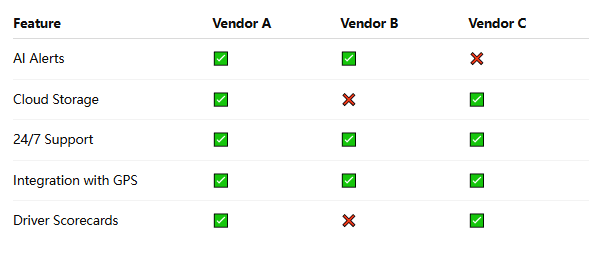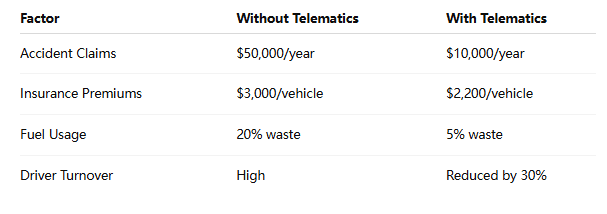Fleet management is evolving—and fast. As technology continues to transform logistics, safety, and operations, one innovation is gaining massive traction: video telematics. But what is video telematics in fleet management? And why are forward-thinking fleet operators adopting it in droves?
In this in-depth guide, we’ll explore the meaning, functionality, benefits, and future of video telematics in fleet operations. Whether you’re managing a small delivery fleet or a large logistics company, you’ll discover how this powerful technology can drive better safety, efficiency, and insights across your business.
Video telematics refers to the integration of video recording systems—typically dash cams—with GPS tracking and telematics data to provide a complete, real-time picture of a vehicle's journey, surroundings, and driver behavior. Unlike traditional telematics, which focuses on numbers and sensors, video telematics brings visual context to fleet events.
Fleet tracking started with basic GPS navigation. Then came OBD (on-board diagnostics) for engine data. Now, video telematics represents the next generation—merging vision and analytics to improve visibility, compliance, and safety.
To understand how this system works, let’s break down its main components:
These cameras are mounted on windshields to capture external footage—traffic conditions, road hazards, and incidents.
Used to monitor driver fatigue, distraction, or cellphone usage. Some systems use AI to detect eye movement or yawning.
All footage and data are uploaded to the cloud, allowing fleet managers to access, review, and analyze videos remotely.
Combining GPS, accelerometers, and onboard diagnostics, these systems link video events with speed, braking, and location data.
Data Collection: Dash cams record continuous or event-triggered footage.
Transmission: Data is transmitted via cellular networks or Wi-Fi to cloud platforms.
Alerts: Fleet managers receive real-time alerts on hard braking, speeding, or collisions.
AI Analysis: Intelligent algorithms scan video for risky behavior or unusual patterns.
This seamless process helps reduce manual effort and improves response time to incidents.
Enhanced Driver Safety By monitoring risky behavior—like harsh braking or phone use—fleet managers can coach drivers and reduce accident risks.
Insurance and Liability Protection Having video proof of incidents protects companies from fraudulent claims and reduces liability costs.
Operational Efficiency Better route planning and fewer accidents lead to fuel savings and less downtime.
Regulatory Compliance Video telematics helps meet safety regulations and legal requirements more efficiently, such as Hours of Service (HOS) and ELD compliance.
Accident Investigation: Visual evidence of crashes helps pinpoint fault.
Driver Training: Footage is used in feedback sessions and simulations.
Vehicle Recovery: In case of theft, video plus GPS helps locate assets quickly.
These are basic solutions that provide recording and limited telematics integration. Ideal for small fleets looking for low-cost, straightforward monitoring.
These systems combine dash cams, GPS, and telematics tools into one platform. They offer comprehensive analytics, real-time alerts, and custom reporting.
Equipped with machine vision and artificial intelligence, these systems detect fatigue, distraction, tailgating, and even facial expressions—offering predictive safety insights.
One of the main hesitations around video telematics is the perceived invasion of privacy, especially with driver-facing cameras. It’s vital to maintain transparency and educate drivers on how the data is used for safety, not surveillance.
Video footage consumes large amounts of data. Choosing a system with efficient compression and cloud storage can help mitigate these costs.
While initial costs can be significant, the long-term savings on insurance, repairs, and efficiency typically offset the investment.
For fleets operating in the EU or with EU drivers, compliance with GDPR regulations is essential. This includes consent management, secure data storage, and limited access.
Always inform drivers about what’s being recorded, how it’s stored, and how long it will be retained. Transparency builds trust and reduces legal risk.
Real-time streaming
AI-based driver behavior alerts
Cloud access
Integrated GPS and telematics
Easy-to-use dashboards
Is the system scalable for future expansion?
What’s the average data usage?
How secure is the cloud storage?

By monitoring behavior such as speeding, seatbelt use, or hard cornering, managers can assign driver risk scores and build coaching programs. Some platforms even use gamification to reward safe drivers, improving morale and retention.
Advanced video telematics systems use AI to detect real-time risks such as:
Lane drifting
Falling asleep at the wheel
Distracted driving
Tailgating
These systems automatically trigger alerts and video clips, making it easier to respond immediately.
Video telematics works best when integrated with:
GPS tracking for route optimization
ELD systems for compliance tracking
Maintenance platforms for proactive servicing
Such integration provides a centralized dashboard for all fleet operations.
Edge Computing: Cameras with built-in processors for on-device AI analysis
Biometric Recognition: Monitoring drowsiness or identity validation
Predictive Risk Modeling: Anticipating future accidents using historical data and machine learning
Let’s break down a typical scenario:
 Conclusion: Fleets typically see positive ROI within 12–18 months.
Conclusion: Fleets typically see positive ROI within 12–18 months.
The video telematics market is projected to exceed $12 billion by 2030, with widespread adoption across:
Logistics
Construction
School transportation
Emergency services
Fleets that embrace this technology today will gain a competitive edge tomorrow.
To provide visual context to telematics data, improve safety, reduce liability, and enhance operational efficiency.
Some do, while others record based on specific triggers like harsh braking or collisions.
In most commercial-grade systems, camera control is restricted to ensure data integrity and compliance.
Yes, but regulations vary by region. Always inform drivers and comply with local privacy laws.
Reputable systems use end-to-end encryption and cloud backups to keep your data secure.
Logistics, delivery, public transit, construction, and any business operating fleet vehicles.
Video telematics is revolutionizing how fleets operate. By combining visual data with advanced analytics, this technology offers unmatched safety, insight, and control. From reducing collisions to boosting fuel efficiency, the benefits speak for themselves.
If you’re managing a fleet and looking for a way to** optimize operations, reduce costs, and protect your drivers,** then investing in a video telematics system could be one of the smartest decisions you make.
🔗 Further Reading: Geotab's Guide to Video Telematics

BSJ Technology is a global leader in Internet of Things (IoT) solutions providers and intelligent hardware manufacturers. We specialize in developing, designing, producing, and selling intelligent hardware solutions. Our cutting-edge products integrate communication, GPS positioning, and AI technologies to transform industries with more innovative, more efficient solutions. Our industrial solutions and expertise span Smart Fleet Management, Smart Mobility, and Smart Payment.